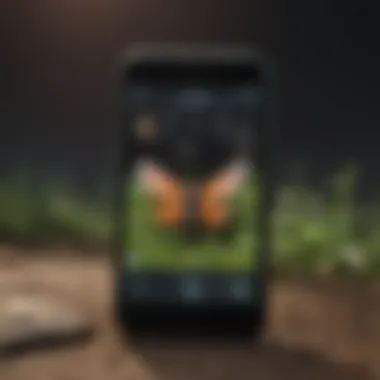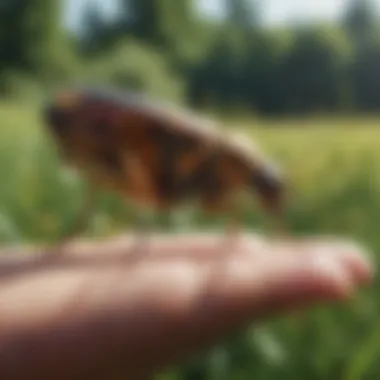Exploring Free Insect Identification Apps Guide


Intro
The subject of insect identification holds significant value for homeowners and enthusiasts alike. Free insect identification apps have emerged as valuable tools in our increasingly technocentric world. These applications not only enhance individual knowledge but also create opportunities for broader engagement with the field of entomology. In understanding the importance of identifying various insect species, one can appreciate their ecological roles and the impacts they may have.
In this guide, we will delve into the functionality of these apps, dissecting their main features, benefits, and challenges. We will examine how such innovative tools serve diverse audiences, including amateur naturalists, researchers, and the general public. By assessing various available applications, readers will gain insights to assist in selecting the most effective tools for pest identification and management.
To provide a thorough perspective, we will highlight common pests, prevention techniques, and eco-friendly pest control options, each supported by actionable advice and recommendations.
Intro to Insect Identification
Insect identification is a crucial skill for many people, especially homeowners and gardening enthusiasts. The presence of insects can significantly impact the health of plants, the integrity of homes, and even personal comfort. Knowing which insects inhabit an area helps in managing pests effectively and safely. Free insect identification apps play a pivotal role in this process. They equip users with the tools to recognize and classify various insect species with ease. Given the increasing interest in eco-friendly gardening and sustainable living, these apps offer practical support to those looking to make informed choices in their pest management strategies.
The Importance of Insect Identification
Understanding the different types of insects is essential for multiple reasons. Firstly, not all insects are harmful; some are beneficial and contribute to pollination, which is crucial for plant health. Identifying a pest versus a helpful insect can save homeowners from unnecessary pesticide use, which might be detrimental to the environment. Moreover, insects can carry diseases or cause damage to structures and gardens. Accurate identification allows for appropriate responses, whether that means encouraging beneficial species or taking action against pests.
In summary, insect identification is not just an academic exercise but a practical necessity in today's diverse ecosystems. Homeowners equipped with this knowledge can contribute positively to their local environment.
Benefits of Free Insect Identification Apps
Free insect identification apps bring several advantages to users. Here are some key benefits:
- Accessibility: These apps are easy to download and use. Even those with limited tech experience can effectively navigate them.
- Instant Results: Users can identify insects in real-time. This immediate feedback empowers homeowners to act quickly when faced with potential pest issues.
- Educational Resource: The apps provide valuable information about species, helping users learn more about their local ecosystem and make informed decisions.
- Community Support: Many apps allow users to share discoveries and help each other identify species. This communal sharing enhances the learning experience.
- Regular Updates: As new species or findings emerge, apps are often updated, keeping users informed about current trends in entomology.
To conclude, the benefits of free insect identification apps largely center on their convenience and utility. They not only facilitate quick identification but also enrich the user's understanding of the surrounding biodiversity, fostering a deeper connection to nature.
How Insect Identification Apps Work
Insect identification apps serve an imperative function by enabling users, from casual enthusiasts to serious researchers, to identify insect species efficiently and accurately. These applications combine advanced technology with user-friendly interfaces to streamline the identification process. This section will elucidate on how these apps operate, emphasizing the technological innovations and user interactions that shape their effectiveness.
Technology Behind the Apps


The technology underpinning insect identification apps is both fascinating and complex. Most apps utilize machine learning and image recognition as their principal tools. When a user captures a photo of an insect, the app analyzes various features such as color, shape, and texture. The image is then compared to a vast database of known species. This method allows the app to predict what the insect might be, providing suggestions based on probability. Many applications rely on convolutional neural networks, a subset of artificial intelligence, to enhance their identification capabilities.
Additionally, some apps incorporate geolocation features, which enable them to suggest species common to the user's locality. This localization helps refine the identification process by filtering out species that are not present in the area.
Moreover, developers continuously update these databases and algorithms based on new findings in entomology, ensuring that the information remains relevant. This makes them increasingly adaptable as technology advances and knowledge in the field grows.
User Input and Data Collection
User input plays a critical role in the efficiency of insect identification apps. When users submit photos, they are often requested to provide additional information such as the location, time of observation, and notable behaviors observed. This information enriches the data pool, allowing developers to refine algorithms and enhance the accuracy of identifications.
Data collection also extends beyond user interaction. Many apps feature community engagement components where users can discuss their findings or submit species confirmations. This collaborative element serves as an informal peer-review mechanism, effectively crowdsourcing data that can be utilized for future updates and improvements.
However, accuracy is highly dependent on user input quality. Clear photographs and comprehensive details greatly improve identification results. Users must be aware that poor-quality images or insufficient information can lead to misidentifications. Awareness of these limitations is essential.
"The effectiveness of insect identification apps heavily relies on the quality of user-submitted data and the technology used for analysis."
In summary, insect identification apps leverage sophisticated technology while relying on active user participation to enhance their identification accuracy. Understanding how these elements interconnect is crucial for users aiming to utilize apps effectively in their entomological endeavors.
Popular Free Insect Identification Apps
The era of technology has paved new paths for insect identification, making it increasingly accessible for housewives and homeowners. Insect identification apps equip everyday users with the ability to recognize various species quickly, thus enhancing their understanding of the ecological environment at their doorstep. These apps offer significant utility beyond mere curiosity; they empower users with the knowledge to manage pests effectively. By exploring popular insect identification apps, one can glean insights into their functionality, advantages, and some critical considerations.
App A: Key Features and User Experience
When evaluating App A, it becomes apparent that user experience is a significant factor. This app prioritizes an intuitive interface, allowing users to navigate with ease. Users can take photos of the insects, which are then analyzed using artificial intelligence to provide rapid identifications. The accuracy of the identification is bolstered by a database that includes thousands of species. Users frequently note how the step-by-step guides embedded within the app enhance the learning process, making it suitable for novices and seasoned enthusiasts alike. Furthermore, the community aspect of the app fosters a sense of connectivity, allowing users to share their findings and seek advice.
App B: Effectiveness in Real-world Identification
App B has carved a niche in its application effectiveness in real-world scenarios. Numerous reviews indicate its high success rate in identifying garden pests and beneficial insects. Homeowners often share experiences where the app helped them distinguish harmful species from helpful ones, ultimately aiding garden maintenance. This utility extends into fields such as gardening and entomology. Serious gardeners rely on the app's information to make informed decisions about pest control. However, an essential aspect of its effectiveness resides in user input. Accuracy can vary based on the quality of images provided, indicating a need for careful usage.
App C: Comparative Analysis
The choice of an insect identification app can significantly impact your understanding and management of household pests.


Case Studies in App Usage
Understanding real-world applications of insect identification apps offers valuable insights into their effectiveness and user experiences. Case studies play a vital role in illustrating not just how these apps function, but also how they fit into the daily lives of various users, both casual and professional. By examining individual accounts, we can identify the strengths and limitations of these tools, shedding light on their practical implications in pest management and education.
Case Study One: Homeowner Experiences
Homeowners often face dilemmas when curious insects appear in their gardens or homes. The uncertainty about whether an insect is a beneficial species or a pest can lead to unnecessary pesticide use. For instance, one homeowner, Sarah, realized she had an influx of an unfamiliar insect species in her vegetable garden. Instead of immediately resorting to chemicals, she downloaded a free insect identification app, such as iNaturalist.
Upon using the app, Sarah was able to photograph the insects and receive rapid feedback from the app's community and databases. The app confirmed that the insects were actually ladybugs—beneficial predators for pests like aphids. This assessment allowed Sarah to refrain from using harmful pesticides and instead adopt methods to enhance ladybug populations in her garden. Her experience illustrates the immediate benefits of such apps in fostering informed decision-making among homeowners.
- Improved Knowledge: Users like Sarah develop a better understanding of local biodiversity.
- Community Engagement: Leveraging user communities can enhance identification accuracy.
- Preventing Harmful Practices: Educating homeowners prevents unnecessary pesticide applications.
Case Study Two: Professional Entomologists
In contrast, professional entomologists often utilize these apps for more scientific purposes, like field research and species monitoring. Dr. Lee, an entomologist, decided to utilize the app Seek by iNaturalist while conducting research in various ecosystems.
During her study on pollinator species in urban settings, she used the app to share findings with colleagues quickly. The app not only aided in rapid identification but also allowed Dr. Lee to gather important data on distribution patterns that could influence conservation efforts.
The key points from Dr. Lee's usage include:
- Efficiency in Data Collection: The app streamlined the process of recording insect sightings.
- Higher Accuracy: Access to a larger database helped in minimizing the margin of error during identifications.
- Collaboration: It facilitated collaboration among researchers, promoting a collective effort in monitoring insect populations and behaviors.
"These apps bridge a gap between home gardening and professional science, ensuring everyone can contribute to understanding our ecosystems."
In summary, the case studies illustrate how diverse user experiences with insect identification apps can highlight their value in domestic settings, as well as professional environments. Insights gained through these real-life examples serve as a testament to the importance of adopting these technological tools in both managing common household issues and advancing scientific research.
Challenges and Limitations of Insect Identification Apps
Insect identification apps provide valuable assistance in recognizing various insect species. However, understanding the challenges and limitations of these tools is crucial for users, particularly homeowners and gardening enthusiasts. An informed approach can lead to better decisions regarding pest management and ecological awareness.
Accuracy of Identifications


Accurate identification is fundamental to the effectiveness of insect identification apps. Many factors can affect accuracy, including image quality, the algorithms used, and the size of the database from which the app draws its information. Some apps rely on databases that may not be well-maintained or updated regularly, leading to discrepancies in identifications. Moreover, certain insect species have numerous look-alikes, making it difficult even for experienced users to distinguish between them.
Users should be cautious. Even when apps provide a likely identification, confirmation through additional research or consultation with experts is often necessary. High-resolution photos taken from multiple angles can improve the identification process, yet users might lack the knowledge of how to capture effective images.
"Understanding the limitations of identification apps helps users become more discerning in their pest management strategies."
User Error and Misidentification
User error plays a significant role in misidentification. The success of insect identification apps often hinges on user input. For example, if the user selects the wrong category or provides an unclear image, the app’s algorithms may produce inaccurate results. Knowledge gaps regarding insect anatomy or behavior can further lead to mistaken identifications.
To mitigate such errors, it is advisable for users to familiarize themselves with the basic characteristics of common insects in their region. Participating in forums or local entomology groups can also enhance their understanding, ultimately leading to better use of these digital tools. Also, feedback mechanisms within some apps allow users to report errors, fostering an improvement cycle for future identification accuracy.
The Future of Insect Identification Technology
The exploration of insect identification technology presents a pivotal focus for both enthusiasts and professionals in entomology. The advancements in apps that aid in insect identification not only enhance knowledge but also promote conservation efforts. Understanding this future landscape is crucial as it shapes how we interact with and understand the natural world around us.
Innovations on the Horizon
Recent innovations are promising to transform the way we identify insects. One noteworthy advancement is the integration of artificial intelligence into identification apps. AI can analyze images taken by users and provide accurate identification within seconds. Furthermore, machine learning algorithms continue to improve with every interaction, refining data accuracy over time.
Other innovations include the use of augmented reality. This technology allows users to visualize information about insects in real-time. By pointing their device at an insect, users can receive instant information about its species, behavior, and habitat. Such interactive features enhance user engagement and knowledge acquisition.
Potential for Integration with Other Technologies
The integration of identification apps with various other technologies holds significant potential. For instance, linking these apps with geographical information systems (GIS) can enable users to track insect populations across different regions. This data could be invaluable for researchers, allowing them to study migration patterns and seasonal behaviors effectively.
Moreover, partnerships with citizen science platforms like iNaturalist provide opportunities for broader community involvement in entomological research. As users identify and document insects using these apps, their contributions can build large databases for scientific analysis. This trend emphasizes a collective effort in studying biodiversity and ecology.
The future of insect identification lies in collaborative efforts between technology and user engagement, shaping both scientific understanding and conservation awareness.
The End
In this article, we assessed the role of free insect identification apps in promoting both awareness and understanding of entomological diversity. These tools are invaluable for homeowners, gardening enthusiasts, and anyone looking to engage with the natural world. They not only facilitate the identification of various insect species but also serve as a gateway for deeper learning and exploration in the field of entomology.
The benefits of using these apps include accessibility to information, ease of use, and the encouragement of citizen science. Users can contribute data on local insect populations, enhancing the body of knowledge available to scientists and researchers. By being equipped with the ability to identify and understand insects better, individuals become more informed about pest management and ecological balance, which is crucial in maintaining healthy gardens and homes.
However, it is important to approach these apps with a critical eye. While technology has advanced, the accuracy of identifications is not always guaranteed. User error can lead to misidentification, which may have detrimental effects, especially in pest control or invasive species management. Thus, users should cross-check findings with other resources and maintain awareness of the limitations inherent in these applications.
As we look to the future, it is clear that insect identification technology will continue to evolve, further integrating with developments in artificial intelligence and machine learning. This evolution holds promise for enhancing accuracy and user experience, ultimately making insect identification more reliable and informative.







